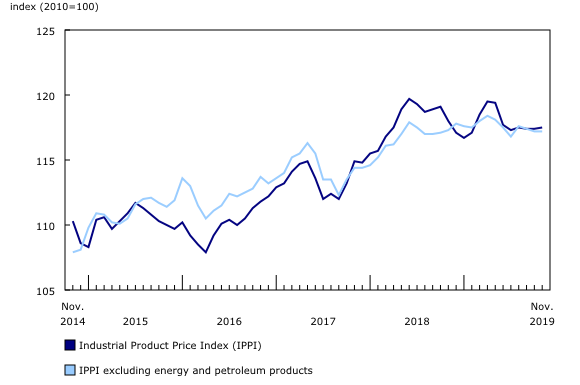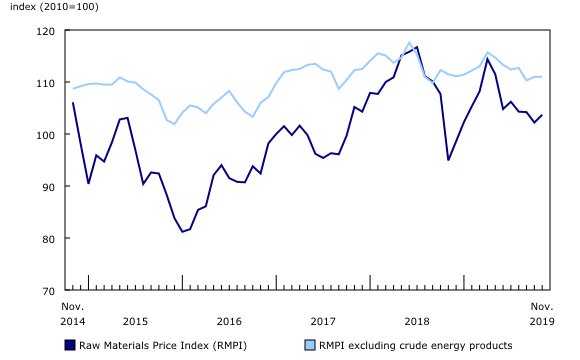Industrial product and raw materials price indexes, November 2019
Archived Content
Information identified as archived is provided for reference, research or recordkeeping purposes. It is not subject to the Government of Canada Web Standards and has not been altered or updated since it was archived. Please "contact us" to request a format other than those available.
Released: 2020-01-06
Prices for products manufactured in Canada, as measured by the Industrial Product Price Index (IPPI), edged up 0.1% in November. Higher prices for meat, fish and dairy products, for energy and petroleum products, and for motorized and recreational vehicles were mostly offset by lower prices for primary non-ferrous metal products. Prices for raw materials purchased by manufacturers operating in Canada, as measured by the Raw Materials Price Index (RMPI), were up 1.5%, primarily because of higher prices for crude energy products.
Industrial Product Price Index
The Industrial Product Price Index (IPPI) rose 0.1% in November, after posting no change in October. The IPPI excluding energy and petroleum products was unchanged.
Of the IPPI's 21 major commodity groups, 8 were up, 9 were down, and 4 were unchanged.
Meat, fish and dairy products were up 1.3%, mostly because of higher prices for fresh and frozen beef and veal (+6.5%), which posted their largest increase since July 2014 (+7.3%). The increase in November was attributable, in part, to higher demand during the holiday season.
Primary non-ferrous metal products were down 1.0%, mostly because of lower prices for unwrought silver and silver alloys (-13.2%). This was the second consecutive monthly decrease in unwrought silver and silver alloys, and the largest decline since October 2011, when the price decreased by 16.0%. However, compared with November 2018, this commodity was up 6.4%.
Energy and petroleum products were up 0.3%, driven mostly by higher prices for light fuel oils (+2.8%) and diesel fuel (+2.7%). This increase was primarily moderated by lower prices for motor gasoline (-1.3%), and asphalt (except natural) and asphalt products (-5.3%).
Motorized and recreational vehicles were up 0.3%, coinciding with the depreciation of the Canadian dollar against the US dollar in November. The increase was mostly driven by higher prices for passenger cars and light trucks (+0.2%), motor vehicle engines and motor vehicle parts (+0.3%), and aircraft (+0.4%).
Chemicals and chemical products were down 0.3%, primarily because of lower prices for plastic resins (-1.5%).
On a year-over-year basis, the IPPI was down 0.4%. Downward influences included energy and petroleum products (-2.5%), pulp and paper products (-7.8%), and chemicals and chemical products (-3.5%). Upward price influence came primarily from meat, fish and dairy products (+3.8%), and motorized and recreational vehicles (+1.0%).
Raw Materials Price Index
The Raw Materials Price Index (RMPI) was up 1.5% in November. The RMPI excluding crude energy products was unchanged.
Of the RMPI's six major commodity groups, two were up, one was down and three were unchanged.
The increase was primarily because of higher prices for conventional crude oil (+3.7%). For the past six months, the price level for conventional crude oil has oscillated. From June to November, the prices increased by 0.5%.
The animals and animal products commodity group was down 0.2%. Within the group, prices for hogs were down 2.8%, while prices for cattle and calves were up 1.3%.
On a year-over-year basis, the RMPI was up 9.3%. The increase was primarily because of higher prices for conventional crude oil (+25.9%).
Note to readers
The Industrial Product Price Index (IPPI) and the Raw Materials Price Index (RMPI) are available at the Canada level only. Selected commodity groups within the IPPI are also available by region.
With each release, data for the previous six months may have been revised. The indexes are not seasonally adjusted.
The Industrial Product Price Index reflects the prices that producers in Canada receive as goods leave the plant gate. It does not reflect what the consumer pays. Unlike the Consumer Price Index, the IPPI excludes indirect taxes and all costs that occur between the time a good leaves the plant and the time the final user takes possession of it, including transportation, wholesale and retail costs.
Canadian producers export many goods. They often indicate their prices in foreign currencies, especially in US dollars, which are then converted into Canadian dollars. In particular, this is the case for motor vehicles, pulp and paper products, and wood products. Therefore, fluctuations in the value of the Canadian dollar against its US counterpart affect the IPPI. However, the conversion into Canadian dollars reflects only how respondents provide their prices. This is not a measure that takes into account the full effect of exchange rates.
The conversion of prices received in US dollars is based on the average monthly exchange rate established by the Bank of Canada and available in table 33-10-0163-01 (series v111666275). Monthly and annual variations in the exchange rate, as described in the release, are calculated according to the indirect quotation of the exchange rate (for example, CAN$1 = US$X).
The Raw Materials Price Index reflects the prices paid by Canadian manufacturers for key raw materials. Many of those prices are set on the world market. However, as few prices are denominated in foreign currencies, their conversion into Canadian dollars has only a minor effect on the calculation of the RMPI.
Products
Statistics Canada has launched the Producer Price Indexes Portal as part of a suite of portals for prices and price indexes. This webpage provides Canadians with a single point of access to a variety of statistics and measures related to producer prices. The portal offers an array of information on topics such as manufacturing, construction, professional services, distributive trades and financial services. The portal will be updated regularly as new information becomes available.
The video "Producer Price Indexes" is available on the Statistics Canada Training Institute webpage. It provides an introduction to Statistics Canada's producer price indexes—what they are, how they are made and what they are used for.
A Historical Timeline of Canadian Producer Price Statistics
The research paper "A Historical Timeline of Canadian Producer Price Statistics," part of the Prices Analytical Series (62F0014M), was created to showcase key milestones in the history of Canadian producer price statistics. This historical timeline contains answers to questions such as "Who collected Canada's first statistics?" and "What do Canadian producer price indexes measure?"
Infographic: Producer Price Indexes at a Glance
The infographic "Producer Price Indexes at a Glance," part of the series Statistics Canada — Infographics (11-627-M), demonstrates how producer price indexes for goods and services are calculated, and why they are important for the Canadian economy.
Real-time table
Real-time table 18-10-0248-01 will be updated on January 13, 2020.
Next release
The industrial product and raw materials price indexes for December 2019 will be released on January 31, 2020.
Contact information
For more information, or to enquire about the concepts, methods or data quality of this release, contact us (toll-free 1-800-263-1136; 514-283-8300; STATCAN.infostats-infostats.STATCAN@canada.ca) or Media Relations (613-951-4636; STATCAN.mediahotline-ligneinfomedias.STATCAN@canada.ca).
- Date modified:




